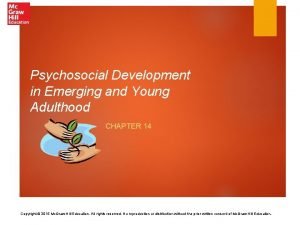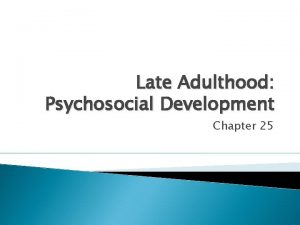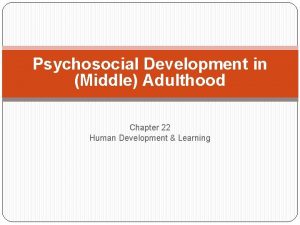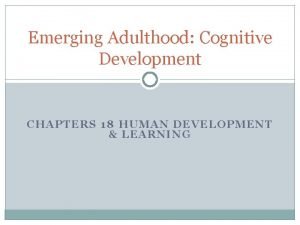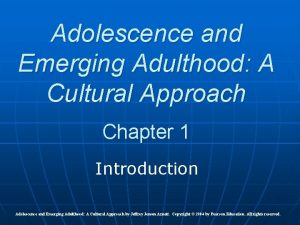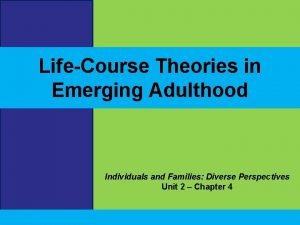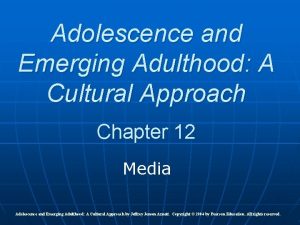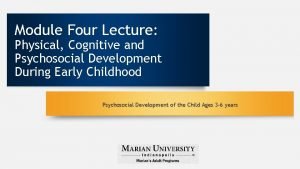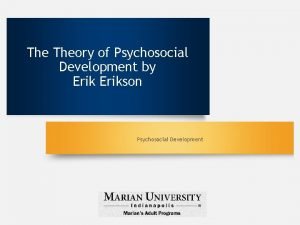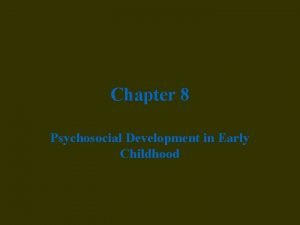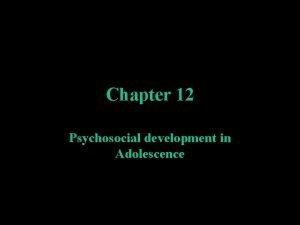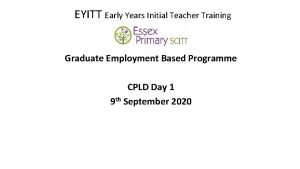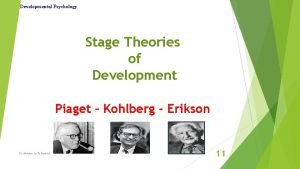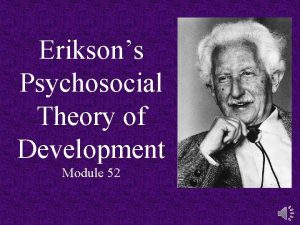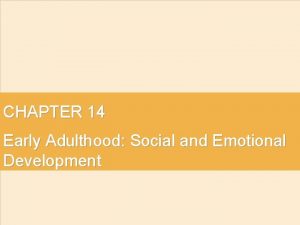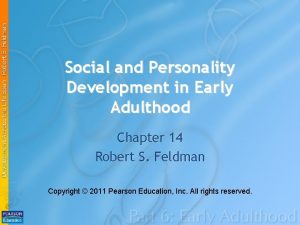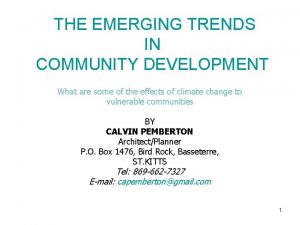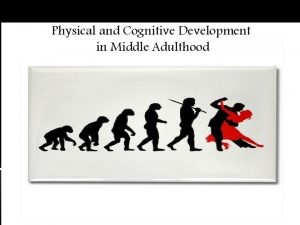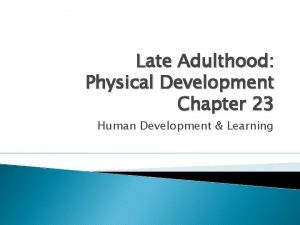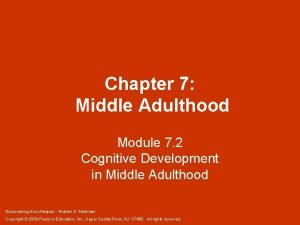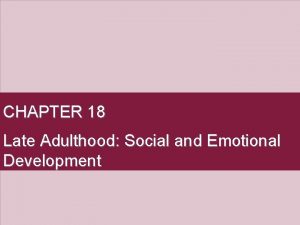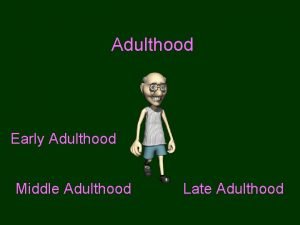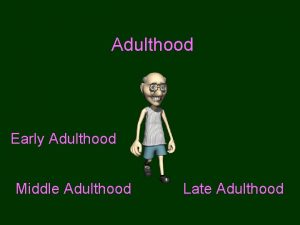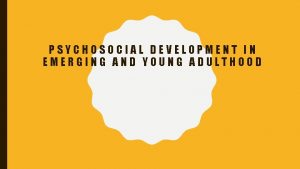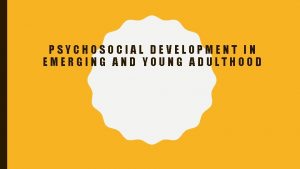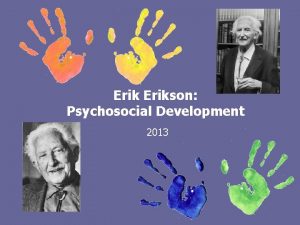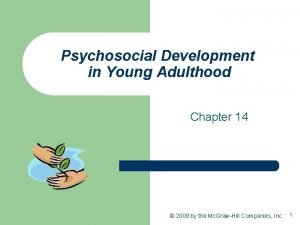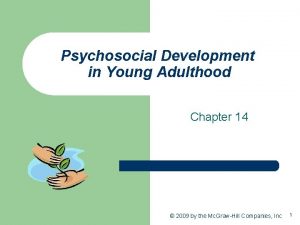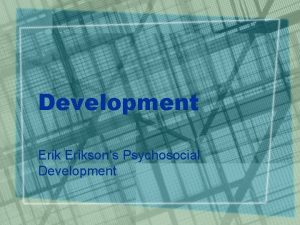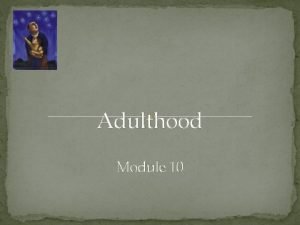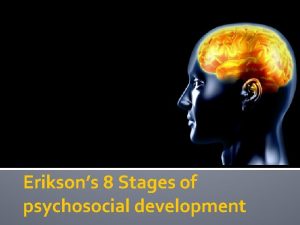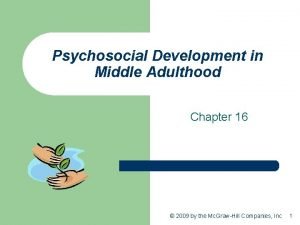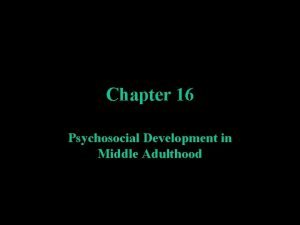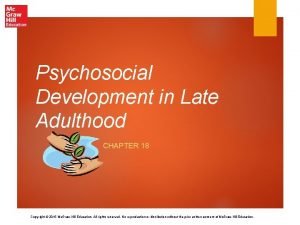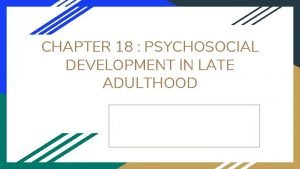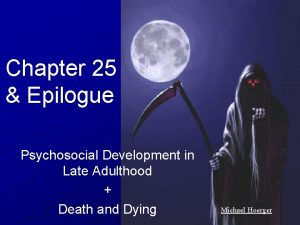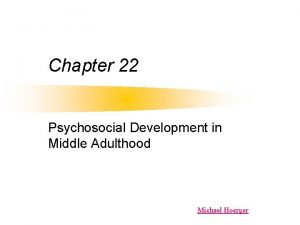Psychosocial Development in Emerging and Young Adulthood CHAPTER


































- Slides: 34

Psychosocial Development in Emerging and Young Adulthood CHAPTER 14 Copyright © 2015 Mc. Graw-Hill Education. All rights reserved. No reproduction or distribution without the prior written consent of Mc. Graw-Hill Education.

Research in Action: The Millennials Do you…. Watch more than an hour of television a day? Have a tattoo or piercing in a place other than your earlobe? Send more than 10 text messages a day? Have a profile on a social networking site? © 2015 Mc. Graw-Hill Education

Identity Development Recentering Stage 1 — Still embedded in family of origin Stage 2 — Connected to family, but moving toward serious commitments and gaining resources to support them Stage 3 — Independence from family of origin, with increased commitment to career, partner, and possibly children © 2015 Mc. Graw-Hill Education

Identity Development Contemporary moratorium “Youthhood, ” a permanent alternative to adulthood Racial/ethnic identity exploration To achieve ethnic identity must understand self as part of ethnic group and as part of wider diverse society © 2015 Mc. Graw-Hill Education

Developing Adult Relationships with Parents One measure of how successfully emerging adults handle becoming autonomous is their ability to remain connected with parents Parents and children seem to get along best when normative life course is followed Failure to launch—adult children who continue to live with parents © 2015 Mc. Graw-Hill Education

Perkembangan Kepribadian: Empat Pandangan Model Tahap Normative (Normative stage models) Model Waktu Peristiwa (Timing of events model) Model Trait (Trait models) Model Tipologis (Typological models) © 2015 Mc. Graw-Hill Education

Erikson’s Normative Stage Model Berkaitan dengan perkembangan psikososial berdasarkan urutan pasti perubahan-perubahan terkait usia Intimacy vs. Isolation Tahap psikososial dimana orang dewasa dituntut untuk saling berkomitmen atau menghadapi rasa pengasingan diri dan keterpakuan pada diri sendiri Bila orang dewasa tidak dapat menjalin komitmen pribadi dengan orang lain mereka berisiko untuk terisolasi dan terpaku pada diri sendiri (Self absorption) © 2015 Mc. Graw-Hill Education

Timing-of-Events Model Mendeskripsikan kepribadian orang dewasa sebagai respon terhadap terjadinya dan waktu terjadinya peristiwa penting dalam kehidupan Normative life events Pengalaman hidup yang umumnya diharapkan terjadi pada masa tertentu. Jika diharapkan = On time/tepat waktu Tidak diharapkan = Off time Social clock Norma/harapan masyarakat terhadap jadwal yang pantas dari suatu peristiwa tertentu dalam kehidupan © 2015 Mc. Graw-Hill Education

Costa and Mc. Crae’s Five Factor Model (Model Trait) Five Factors Neuroticism Extraversion Openness to experience Conscientiousness Agreeableness © 2015 Mc. Graw-Hill Education

Trait Models: Five Factors of Personality © 2015 Mc. Graw-Hill Education

Typological Models Jack Block was pioneer in this approach Tiga tipe kepribadan Ego-resilient Adaptibilitas terhadap sumber stres Overcontrolled Undercontrolled © 2015 Mc. Graw-Hill Education

Foundations of Intimate Relationships Self-disclosure Self-awareness and empathy Ability to communicate emotions Conflict resolution Commitment Sexual decision making © 2015 Mc. Graw-Hill Education

Friendship in Young Adulthood Center on work and parenting activities Sharing of confidences and advice Young singles rely on friendship for social needs Women have social needs met by friends more than men © 2015 Mc. Graw-Hill Education

Sternberg’s Triangular Subtheory of Love Three elements of love: 1. Intimacy Emotional element Involves self-disclosure 2. Passion Motivational element Translates physiological arousal into sexual desire 3. Commitment Cognitive element Decision to love and stay with the beloved © 2015 Mc. Graw-Hill Education

Marital and Nonmarital Lifestyles Single Life Young adults 25– 34 who have not yet married: 54% in 2010 © 2015 Mc. Graw-Hill Education

Gay and Lesbian Relationships About 40– 60% of gay men and 45– 80% of lesbians are in romantic relationships Differences between gay/lesbian relationships and heterosexuals ones • More likely to negotiate household choice • Resolve conflicts in more positive atmosphere • Less stable, due to lack of institutional supports © 2015 Mc. Graw-Hill Education

Legalizing Same-Sex Marriages World: The Netherlands first to legalize, 2001 Belgium, 2003 More than a dozen European countries have recognized same-sex unions U. S. Supreme court ruled federal government was obligated to recognize gay marriage in states where it is legal Gay marriage legal in 17 states with others having legislation pending © 2015 Mc. Graw-Hill Education

Cohabitation Unmarried couples who are involved in a sexual relationship and live together. In U. S. estimated 7. 5 million people living together © 2015 Mc. Graw-Hill Education

Cohabitation in the U. S. Appears to be in transition 4% of U. S. households Higher divorce rates among previous cohabiters – More than half of U. S. couples who marry live together first May reflect people’s traits, rather than the experience of cohabitation itself Meaning of cohabitation is different for older couples © 2015 Mc. Graw-Hill Education

Marriage In the U. S. 90% of adults will marry at some point in their adult life. Age of marriage has risen in most industrialized countries Benefits Division of labor Economic security Commitment, friendship Opportunity for emotional growth New sources of identity and self-esteem © 2015 Mc. Graw-Hill Education

Entering Matrimony Historically mates chosen by matchmakers Only in modern times do people choose mates based on love Typical marrying age has increased in industrialized countries Men: 27 years Women: 25 years © 2015 Mc. Graw-Hill Education

Marital Satisfaction Married people tend to be happier than unmarried people Those in unhappy marriages are less happy than unmarried or divorced people Factors affecting satisfaction: Expectations Economic resources Equal decision making Nontraditional gender attitudes © 2015 Mc. Graw-Hill Education

Factors in Marital Success Partners’ happiness with the relationship Sensitivity to each other Validation of each other’s feelings Communication Conflict management skills Age at marriage College graduates © 2015 Mc. Graw-Hill Education

Parenthood People in industrialized countries having fewer children and later in life Increasing proportions of U. S. couples are remaining childless Parenthood can be key developmental experience © 2015 Mc. Graw-Hill Education

Average Age of Mothers at First Birth © 2015 Mc. Graw-Hill Education

Men & Women: Involvement in Parenthood Both have a mixture of feelings Excitement, anxiety, responsibility Mothers are more involved than fathers in children’s lives Married women complain of more housework and marital conflict Involved fathers tend to be more satisfied with their lives © 2015 Mc. Graw-Hill Education

Marital Satisfaction & Parenthood Marital satisfaction declines during childrearing years, especially infanthood Mothers who saw themselves as unable to cope with demands of motherhood were dissatisfied Fathers most involved with children were more satisfied with their lives © 2015 Mc. Graw-Hill Education

How Dual-Income Families Cope Beneficial to mental and physical health Women have a greater share of economic power Reduces the economic pressure on men © 2015 Mc. Graw-Hill Education

Drawbacks of Dual-Earner Families Possible Extra rivalry between spouses demands on time and energy Anxiety and guilt about meeting children’s needs © 2015 Mc. Graw-Hill Education

When Marriage Ends Divorce Average marriage that ends in divorce does so after 7– 8 years One in five U. S. adults has been divorced Rates twice as high as 1960 Sharpest drop in divorce rates is among younger cohorts © 2015 Mc. Graw-Hill Education

Possible Reasons for Divorce Incompatibility and lack of emotional support Younger women said lack of career support Spousal abuse © 2015 Mc. Graw-Hill Education

Research in Action: Intimate Partner Violence Victims are predominantly young, poor, less educated, divorced, or cohabiting Three types of violence Situational couple violence Emotional abuse Intimate terrorism Shelters and law enforcement support © 2015 Mc. Graw-Hill Education

Adjusting to Divorce tends to reduce long-term well-being Men: Negative effects on health Disruption of parent-child relationships Loss of emotional support Discord with former spouse Economic hardship Women more likely to live in poverty postdivorce © 2015 Mc. Graw-Hill Education

Remarriage and Stepparenthood One-third of U. S. marriages are remarriages for both bride and groom One-fourth of stepfamilies are formed by cohabitation Many families adjust and create a nurturing atmosphere © 2015 Mc. Graw-Hill Education
 Emerging adulthood psychosocial development
Emerging adulthood psychosocial development Psychosocial development in late adulthood
Psychosocial development in late adulthood Physical changes early adulthood
Physical changes early adulthood Permaparenting
Permaparenting Emerging adulthood cognitive development
Emerging adulthood cognitive development Jeffrey arnett emerging adulthood theory
Jeffrey arnett emerging adulthood theory Jeffrey arnett emerging adulthood theory
Jeffrey arnett emerging adulthood theory Jeffrey arnett emerging adulthood theory
Jeffrey arnett emerging adulthood theory Define physical cognitive and psychosocial development
Define physical cognitive and psychosocial development Psychodynamic theory erikson
Psychodynamic theory erikson Chapter 7 human growth and development
Chapter 7 human growth and development Trust vs. mistrust examples
Trust vs. mistrust examples Psychosocial.development
Psychosocial.development Psychosocial development in early childhood
Psychosocial development in early childhood Psychosocial development in adolescence
Psychosocial development in adolescence Erickson's psychosocial theory of development
Erickson's psychosocial theory of development Psychology stages of development
Psychology stages of development Trust vs. mistrust
Trust vs. mistrust Chapter 10:1 myths on aging
Chapter 10:1 myths on aging Early adulthood cognitive development
Early adulthood cognitive development Emotional development is often stormy and in conflict
Emotional development is often stormy and in conflict Emotional development in middle adulthood
Emotional development in middle adulthood Emotional growth
Emotional growth Physical and cognitive development in early adulthood
Physical and cognitive development in early adulthood Personality development in early adulthood
Personality development in early adulthood Emotional development in late adulthood
Emotional development in late adulthood Trends in community development
Trends in community development Psychosocial and aesthetic factors
Psychosocial and aesthetic factors Cognitive development for middle adulthood
Cognitive development for middle adulthood Filial maturity
Filial maturity Physical development in late adulthood
Physical development in late adulthood Intellectual development in later adulthood
Intellectual development in later adulthood Late childhood mental development
Late childhood mental development Cognitive development middle adulthood
Cognitive development middle adulthood Pecks developmental tasks
Pecks developmental tasks
